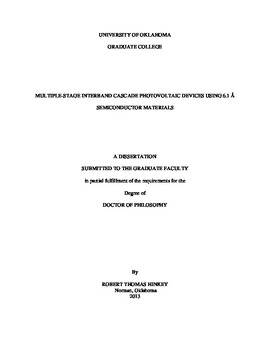| dc.description.abstract | Interband cascade photovoltaic (IC PV) structures are an attractive alternative to the conventional long-absorber diode structures currently used for mid-infrared photovoltaic devices. The unique feature of IC PV devices is that they utilize a multiple-stage architecture. This sort of design is made possible by the type-II broken-gap alignment between InAs and GaSb. In a multiple-stage device, electrons must be excited several times by above-bandgap photons in order to pass between the device contacts. Although counterintuitive, this transport feature can be beneficial for both energy-conversion and infrared detector technology. In particular, the interband cascade approach should be useful for improving the performance of narrow-bandgap optoelectronic devices operating at high temperature by ensuring a more efficient usage of the incident photons. The aim of this dissertation is to identify and demonstrate the advantages that interband cascade photovoltaic devices offer, both theoretically and experimentally.
A theoretical framework for studying signal and noise in multiple-stage interband photovoltaic devices is presented. The theory flows from a general picture of electrons transitioning between thermalized reservoirs. Making the assumption of bulk-like absorbers, we show how the standard semiconductor transport and recombination equations can be extended to the case of multiple-stage devices. The electronic noise arising from fluctuations in the transition rates between reservoirs is derived using the Shockley-Ramo and Weiner-Khintchine theorems. This provides a unified noise treatment accounting for both the Johnson and shot noise. In this framework, we derive consistent analytic expressions for the quantum efficiency and thermal noise in terms of the design parameters and macroscopic material properties of the absorber.
The theory is then applied in order to quantify the potential performance improvement that can be gained from the use of multiple stages. We show that multiple-stage detectors can achieve higher sensitivities for applications requiring a very fast temporal response. This is shown by deriving an expression for the optimal number of stages in terms of the absorption coefficient and absorber thicknesses for a multiple-stage detector with short absorbers. The multiple-stage architecture may also be useful for improving the sensitivity of high operating temperature detectors, if a short diffusion length limits the quantum efficiency. The potential sensitivity improvement offered by a multiple-stage architecture can be judged from the product of the absorption coefficient, α, and diffusion length, Ln, of the absorber material. For detector designs where the absorber lengths in each of the stages is equal, the multiple-stage architecture offers the potential for significant detectivity improvement when αLn ≤ 0.2. We also explore the potential of multiple-stage detectors with photocurrent-matched absorbers. In this architecture, the absorbers are designed to absorb and collect an equal number of carriers in each stage. It is shown that for zero-bias operation, this design has a higher ultimate detectivity than a single-absorber device. Such improvements in detectivity are significant for material with αLn ≤ 0.5. Additionally, for photocurrent-matched detectors, it is shown that when the noise is limited by the inherent fluctuations in a strong signal, the detectivity improvement possible scales with the square of the improvement in particle conversion efficiency. Using the results derived for general values of αLn, we offer an outlook for multiple-stage detectors that utilize InAs/GaSb superlattice absorbers.
The experimental characterization of a series of IC PV devices designed for radiative energy conversion is presented. Devices utilizing InAs/GaSb superlattice (SL) absorbers and others using InAs/Al0.8In0.2Sb/GaSb/Al0.8In0.2Sb SL absorbers are characterized. In the latter devices, the thin layer of Al0.8In0.2Sb enabled a wider absorber bandgap to be realized. This led to an improved efficiency at high temperature. For both sets of the devices, the power conversion efficiency is found to be limited by a low fill factor. A variable-area analysis of a series of the wider-bandgap devices revealed the devices suffered from significant surface shunting effects. This shunting is also shown to limit the open-circuit voltage.
An experimental comparison of single- and multiple-stage infrared detectors is also detailed. These detectors utilized absorbers composed of InAs/GaSb superlattices. The cutoff wavelengths of these detectors was in the mid-wave infrared. Similar to the energy-conversion devices, these detectors had dark currents limited by surface leakage effects. For the set of devices studied, it is shown that multiple-stage detectors using short absorbers are able to achieve higher values of RoA and have a photoresponse that is less sensitive to temperature. The sensitivity of the multiple-stage devices, as characterized by the specific detectivity, exceeds that of the single-stage devices at ambient temperatures and above. This provides direct evidence of the utility of these devices for high-temperature detector operation. | en_US |
